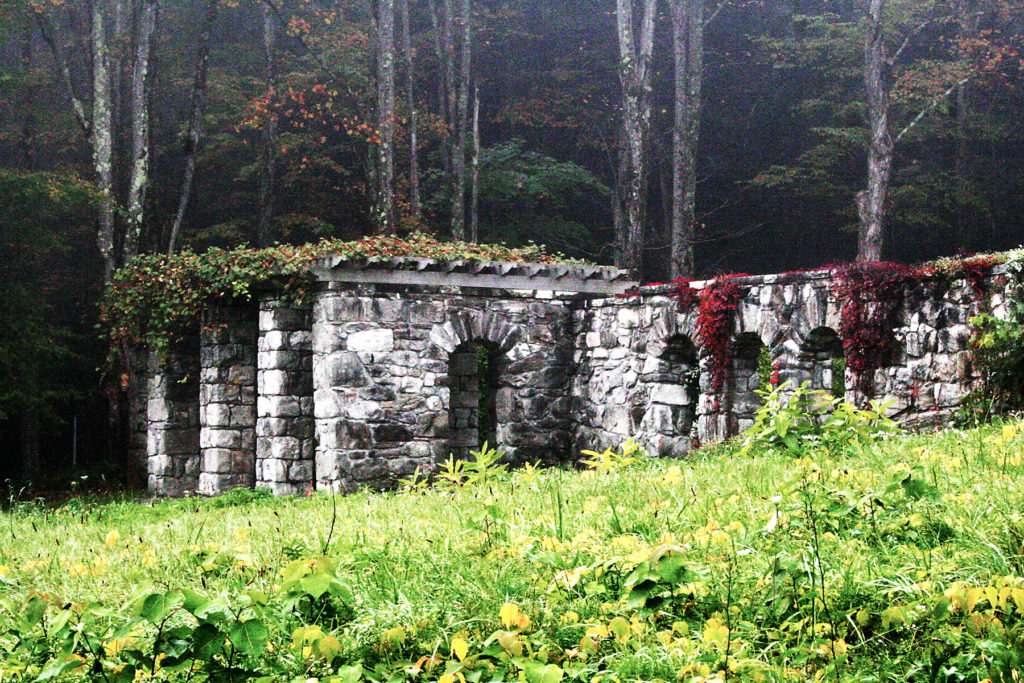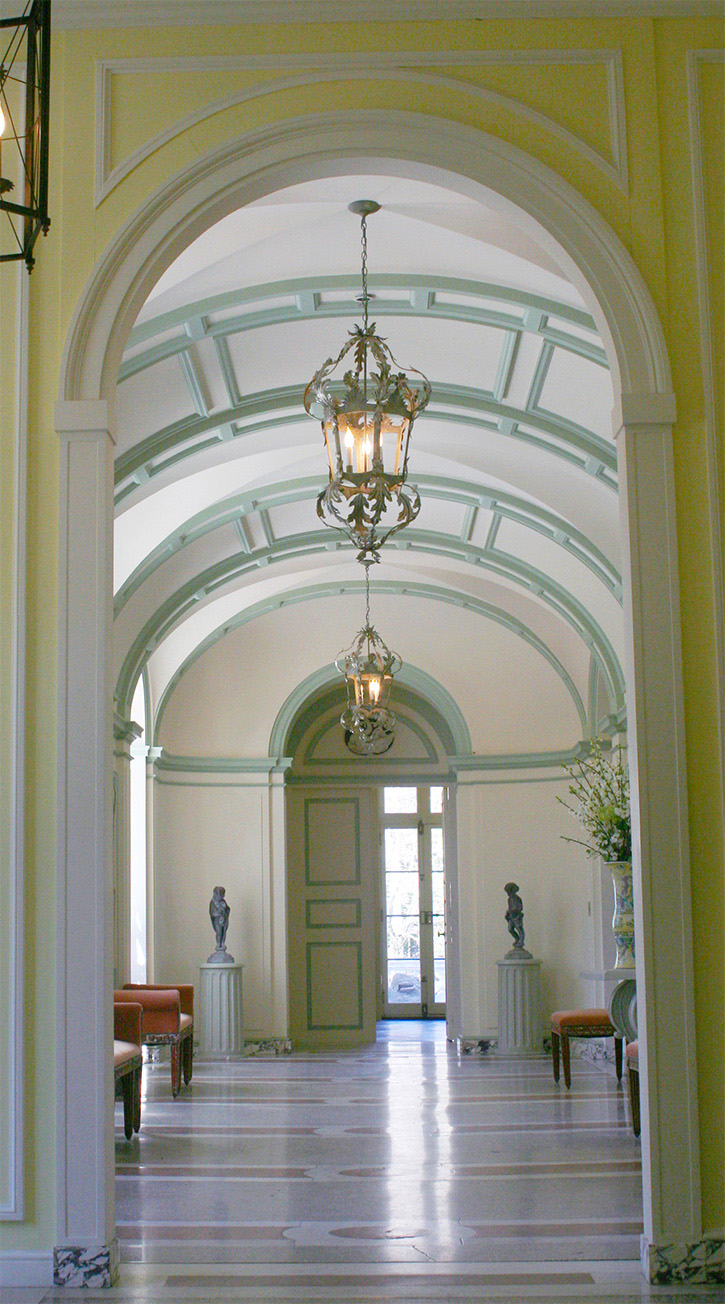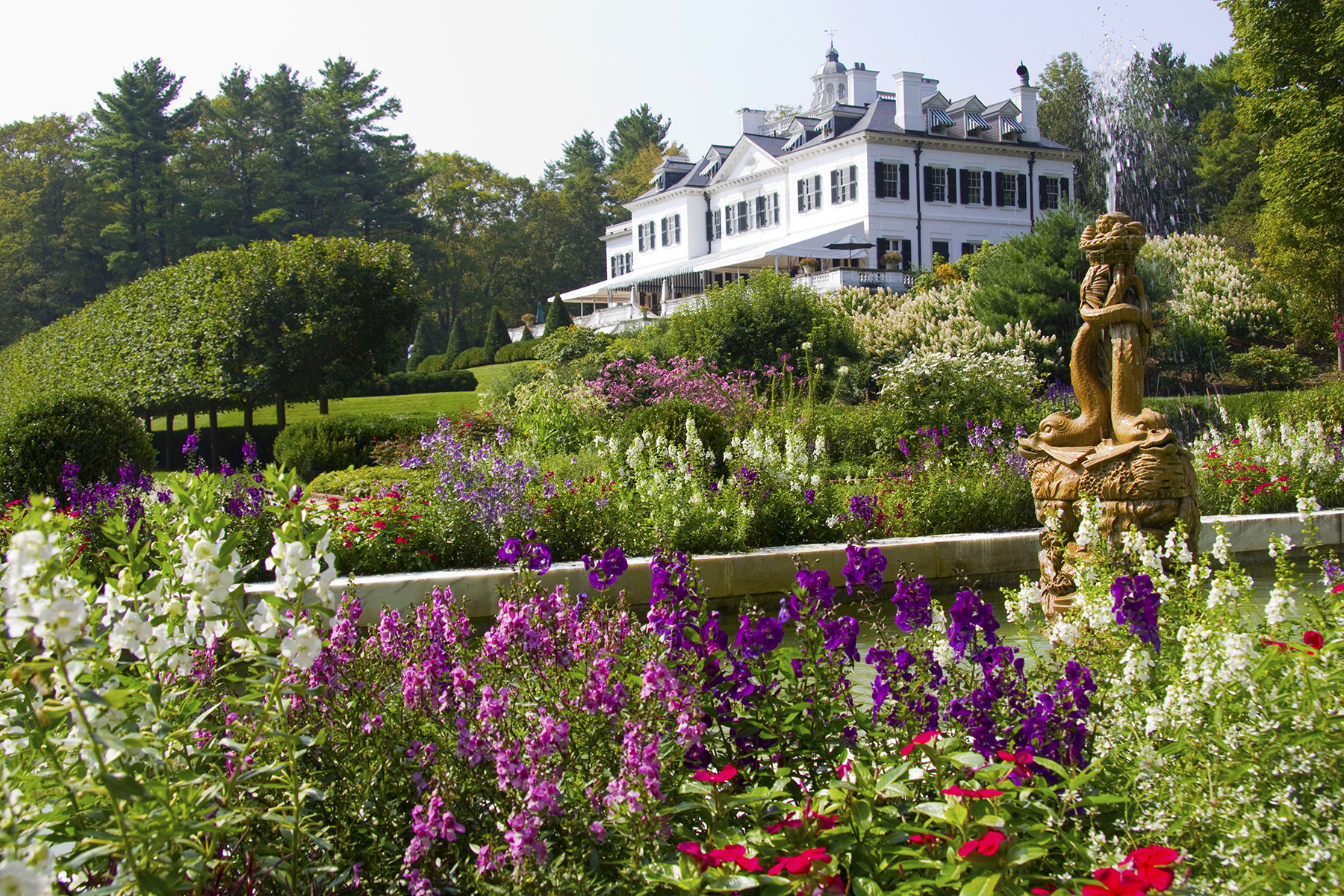by Robin Catalano
The homes of favorite authors are always must-stops on my travel itineraries. But perhaps owing to the old adage “Never meet your heroes,” the reality of where my favorite writers lived and worked has usually been less than remarkable, running the rather limited gamut from the spartan and unexceptional to the unkempt, if not derelict.
The Mount, Edith Wharton’s Home, in Lenox, Massachusetts, seemed destined to follow the same pattern. My first visit, shortly after I’d moved to the area in 1996, was, to put it politely, underwhelming. Having been benignly neglected for half a century, first as a girls’ boarding school and then as the backdrop for theatrical productions, The Mount was a despondent collection of yawning rooms, yellow tape–lined construction zones, and shaggy, overgrown gardens.
Since then, The Mount, one of only 5 percent of National Historic Landmarks dedicated to women, has undergone one of the most striking transformations of any historic property in the Berkshires. I’ve been back nearly every year, and each visit has left me with the feeling that there’s more to discover. So on a cold, windy April day, I headed out again, this time with the mission to not just look at the pretty overall picture, but to put myself in Edith’s natty shoes and experience The Mount as a reflection of the extraordinary life lived within its walls.
Turning off Route 7, I slowed to a putter through the white gates and eased down the long drive, past the long Georgian Revival stable and wooded trails. Under the bright sun, the grassy lawns turned the supersaturated color of golf turf, throwing the house into stark relief—the ghost of a period in history that managed to be both excessive and restrictive at the same time.
In 1901, Edith and her husband, Teddy Wharton, purchased this secluded property. The official reason: they wanted more privacy than what their Newport home—located directly across the street from Edith’s mother’s house—afforded. The underlying truth: the bookish Edith was always something of an outsider in the bon ton, the Whartons were not well-matched, and Teddy suffered from bipolar disorder. The move allowed them to shield their interpersonal tensions, as well as Teddy’s deteriorating mental illness, from high-society tongue-wagging.
Edith, who had extensive knowledge of architecture, born of decades of travel and independent study, designed the home herself. She patterned it on Belton House, a circa-1680 English mansion built in the Carolean style, mixing classical French and Italian design into her own country “cottage.” Using much of her own money, she engaged architect and interior designer Ogden Codman, with whom she coauthored the seminal 1897 book The Decoration of Houses, to oversee the execution of her vision. The influencers of their day, Wharton and Codman eschewed the extravagance of the period, and instead championed a more restrained aesthetic.
Broad and solid, and measuring nearly 17,000 square feet—not modest by any current standard—The Mount squats over undulating land that tumbles from its grass terraces into a formal European-style flower garden, a sunken and stone-walled Italian garden, a rock garden, and a lime walk. All were designed as outdoor “rooms” by Edith herself, with a considerable assist from niece and landscape designer Beatrix Farrand.
The estate, completed in 1902, is grand, elegant, and voluminous—not surprising for a woman raised in a stylish and wealthy New York City family (the Joneses, who, with their penchant for building ever more luxurious houses, are believed by some to be the inspiration for the phrase keeping up with the Joneses). As I rambled through the gardens and lawns, the wind whispering from leaf to leaf, I had the impression that this is a place where I could, intentionally or not, get lost.

Many historic homes have the chilly, impersonal feel of a museum. But despite The Mount’s tidy, ornate appearance—swooping architectural details, Italian marble fireplaces and baseboards, floor-to-ceiling windows, elaborate plasterwork, curling iron staircase railings, lavish art portraits and tapestries—it feels lived-in, as if Edith just stepped out for a smoke on the back porch. It has what the ancient Romans dubbed genius loci, or spirit of place—but not in a woo-woo or “I see dead people” sense (though some do claim to glimpse specters on the property). Rather, it’s a feeling that something important happened here.
And it did.
The Mount was, in Edith’s estimation, her greatest achievement, better even than The House of Mirth. I’d pick that bone with her, and offer another: though she may not have been conscious of it, the estate was actually a catalyst for groundbreaking personal and professional growth. What’s more, it’s symbolic of a Gilded Age woman, so often subjugated by a repressive society, in full rebel-yell mode.
Before the move to Massachusetts, Edith Wharton was the successful, albeit insecure, author of a volume of poetry, a nonfiction book, two short story collections, and two novels. After taking up residence full-time at The Mount, she blossomed, kicking off a prolific decade that most writers, me included, can only envy. She produced another fourteen books, including best-selling short story collections and full-length novels, among them the classics The House of Mirth and Ethan Frome. (All told, Wharton published more than 40 books. She was also the first woman to be awarded a Pulitzer Prize for fiction, for The Age of Innocence, written in 1920.)
From inside The Mount, it’s easy to see how this evolution unfolded. Edith had the estate created to exacting, often architect-maddening specifications, to meet her every need and wish. Thoreaus of the world be damned; The Mount was not about deliberate living or attaining enlightenment through self-discipline. It was a place that fused the comforts of privilege with spaces dedicated to working, doing business, idling, entertaining well-heeled friends, and daydreaming.
For all her wealth, polish, and career success, Edith was, at heart, a book nerd. She put considerable thought into The Mount’s library, which was designed in a traditional English style, with dark, carved woods, floor-to-ceiling built-in bookcases, and heavy drapery. In contrast to the rest of the house, if feels weightier, more solemn—a place for serious study and discussion.
Click and drag the images left and right to enjoy the slideshow below.
Today, a little more than half of Edith’s original collection of 5,000-odd books occupies the shelves. It’s hard not to be awed by the sheer size of the collection; or Edith’s nomadic interests, from fiction to science, gardening, and religion; or the fact that she read in three languages. Many of the books still retain her original annotations. Some have inscriptions, like Harry Graham’s Misrepresentative Women, a gift from good friend Henry James, who scrawled, “To a much misrepresented woman from one of her largest admirers” on the endpapers.
The other rooms of the house are decidedly lighter in character, and more in keeping with Edith’s design principle of bringing the outdoors in. The pale-hued, light-filled drawing room and dining room, where she entertained a variety of Gilded Age luminaries of literature, art, and the intelligentsia, are two such spaces, as is the main guest bedroom, where frequent visitor James was treated to the best views in the house.
Edith’s bedroom is the room of most significance to her work. Secluded on the east end the house, it’s where she did the vast majority of her writing. It was also the site of Teddy and Edith’s most heated arguments, and some visitors say they can still feel this energy. I’m not much of a mystic, so I didn’t pick up on any unusual vibes—but perhaps that had more to do with the repairs happening on the terrace below. Still, even with contractors belting out snippets of Journey’s “Faithfully” between dueling vacuum choruses, I could see why this room was her preferred place to work.
Click and drag the images left and right to enjoy the slideshow below.
The windows of Edith’s bedroom not only allow morning light to wash across the space; they also look out over extraordinary views of The Mount’s gardens and grounds, and of Laurel Lake in the distance. Edith took advantage of this daydreamy environment, and upon waking nearly every morning, she sipped coffee and gazed through the glass. Then, clad in a flowing nightgown or robes, her hair undone, Wharton balanced a wooden desk on her knees and wrote longhand on numbered pages for hours at a time.
This image of a woman unbound is a remarkable contrast to her novels, which star fashionable people doing fashionable things, and tightly controlled heroines who fairly seethe with the desire to rebel against social strictures. While The Mount undeniably demonstrates Edith’s taste for the finer things, it also embodies the spirit of a woman shrugging off the yoke of society and undergoing profound personal transformation.
Because The Mount was the place where Edith felt the most unfettered, literally and philosophically, she experienced a creative rebirth that led to prodigious commercial and artistic success. It doesn’t escape me that this commercial success made it possible for her, unlike most women of the period, to even entertain a more independent-minded approach to living.
With both financial security and distance from the prying gaze of high society, Edith also came to grips with her dissatisfaction with a loveless marriage, to a man who had never been able to keep up with her. (While this wasn’t the first time she’d intellectually outdistanced a man—her first engagement, in 1882, was broken off because of “an alleged preponderance of intellectuality on the part of the intended bride”—Teddy’s struggle with mental illness presented an additional obstacle. It didn’t help that he “borrowed” $50,000 from her trust fund in 1909 to set himself and his mistress up in a Boston apartment.) And in 1907, she pursued romantic passion for the first time and, at age forty-five, initiated an affair with journalist Morton Fullerton. (She divorced Teddy in 1913.)

Although Edith Wharton as an author is rarely mentioned in the same breath as the word feminism, The Mount was, in many ways, Wharton’s feminist manifesto—equal parts technical and financial achievement, personal statement, and sanctuary where she slipped away from a repressive society to embark on a more authentic life. “It was only at the Mount that I was really happy,” she wrote in A Backward Glance, her 1934 memoir. Even after she left The Mount, she continued to flourish, writing up until her death, at age 75, in 1937.
As I lingered in the brick-walled forecourt of The Mount, a sense of grief rushed through me. In 1911, Edith Wharton, in the midst of her dissolving marriage, mourning the end of an affair with the man she loved, and fearful of looming financial difficulties, stood, possibly in the same spot, gazing at her cherished home for the last time. She would sell The Mount and move permanently to France. But then I remembered what she’d achieved here, and that even though she considered the Lenox home one of the great happy places of her life, she was ready to leave the woman she’d been behind and step into yet another chapter—and this time, she was calling the shots.




























Thank you so much! Each paragraph stirred of this article the memories of my youth. I was a student at Foxhollow School, the year that it closed, & had spent the final summer at school, all alone. (Canoeing in the lagoon, as an art class studied inside “The Mount”.) What’s really amazing, is I never knew the history of the place that educated me…until now. Again, Thank You.